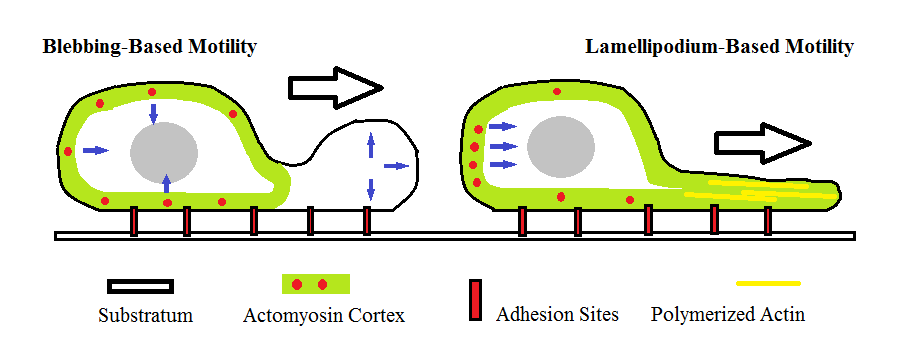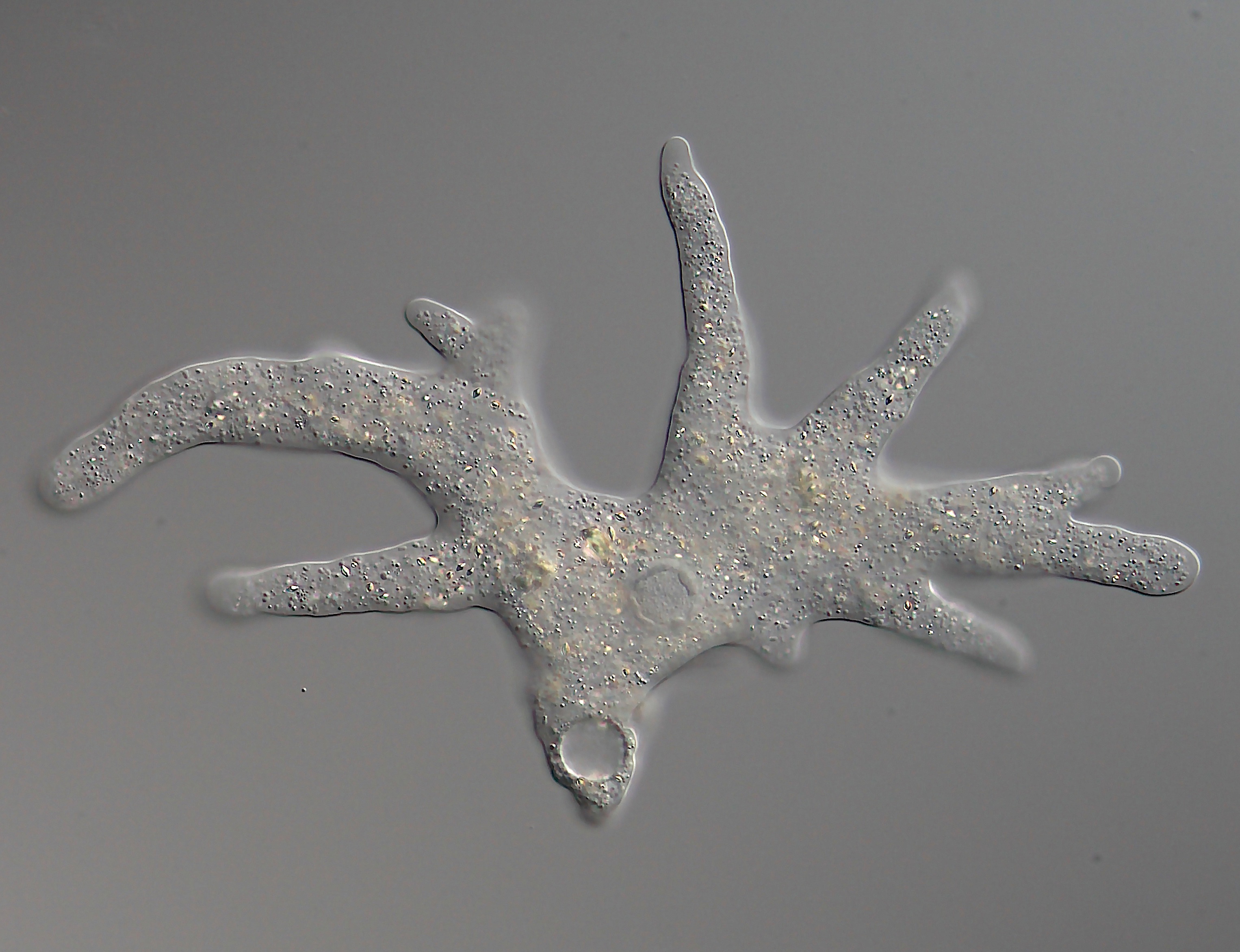|
Amoeboid Movement
Amoeboid movement is the most typical mode of locomotion in adherent eukaryotic cells. It is a crawling-like type of movement accomplished by protrusion of cytoplasm of the cell involving the formation of pseudopodia ("false-feet") and posterior uropods. One or more pseudopodia may be produced at a time depending on the organism, but all amoeboid movement is characterized by the movement of organisms with an amorphous form that possess no set motility structures. Movement occurs when the cytoplasm slides and forms a pseudopodium in front to pull the cell forward. Some examples of organisms that exhibit this type of locomotion are amoebae (such as ''Amoeba proteus'' and '' Naegleria gruberi'',) and slime molds, as well as some cells in humans such as leukocytes. Sarcomas, or cancers arising from connective tissue cells, are particularly adept at amoeboid movement, thus leading to their high rate of metastasis. This type of movement has been linked to changes in action potential ... [...More Info...] [...Related Items...] OR: [Wikipedia] [Google] [Baidu] |
Pseudopodia
A pseudopod or pseudopodium (: pseudopods or pseudopodia) is a temporary arm-like projection of a eukaryotic cell membrane that is emerged in the direction of movement. Filled with cytoplasm, pseudopodia primarily consist of actin filaments and may also contain microtubules and intermediate filaments. Pseudopods are used for motility and ingestion. They are often found in amoebas. Different types of pseudopodia can be classified by their distinct appearances. Lamellipodia are broad and thin. Filopodia are slender, thread-like, and are supported largely by microfilaments. Lobopodia are bulbous and amoebic. Reticulopodia are complex structures bearing individual pseudopodia which form irregular nets. Axopodia are the phagocytosis type with long, thin pseudopods supported by complex microtubule arrays enveloped with cytoplasm; they respond rapidly to physical contact. Generally, several pseudopodia arise from the surface of the body, (''polypodial'', for example, '' Amoeba ... [...More Info...] [...Related Items...] OR: [Wikipedia] [Google] [Baidu] |
Myofibril
A myofibril (also known as a muscle fibril or sarcostyle) is a basic rod-like organelle of a muscle cell. Skeletal muscles are composed of long, tubular cells known as Skeletal muscle#Skeletal muscle cells, muscle fibers, and these cells contain many chains of myofibrils. Each myofibril has a diameter of 1–2 micrometres. They are created during embryogenesis, embryonic development in a process known as myogenesis. Myofibrils are composed of long proteins including actin, myosin, and titin, and other proteins that hold them together. These proteins are organized into Thick filaments, thick, thin filaments, thin, and elastic filament, elastic myofilaments, which repeat along the length of the myofibril in sections or units of contraction called sarcomeres. Muscle contraction, Muscles contract by sliding filament theory, sliding the thick myosin, and thin actin myofilaments along each other. Structure Each myofibril has a diameter of between 1 and 2 micrometres (μm). The filamen ... [...More Info...] [...Related Items...] OR: [Wikipedia] [Google] [Baidu] |
Endoplasm
Endoplasm, also known as entoplasm, generally refers to the inner (often granulated), dense part of a cell's cytoplasm. This is opposed to the ectoplasm (cell biology), ectoplasm which is the outer (non-granulated) layer of the cytoplasm, which is typically watery and immediately adjacent to the plasma membrane. The nucleus is separated from the endoplasm by the nuclear envelope. The different makeups/viscosities of the endoplasm and ectoplasm contribute to the amoeba's locomotion through the formation of a pseudopod. However, other types of cells have cytoplasm divided into endo- and ectoplasm. The endoplasm, along with its granules, contains water, nucleic acids, amino acids, carbohydrates, inorganic ions, lipids, enzymes, and other molecular compounds. It is the site of most cellular processes as it houses the organelles that make up the endomembrane system, as well as those that stand alone. The endoplasm is necessary for most metabolic activities, including cell division. Th ... [...More Info...] [...Related Items...] OR: [Wikipedia] [Google] [Baidu] |
Ectoplasm (cell Biology)
Ectoplasm (also exoplasm) is the non- granulated outer part of a cell's cytoplasm, while endoplasm is its often granulated inner layer. It is clear, and protects as well as transports things within the cell. Moreover, large numbers of actin filaments frequently occur in the ectoplasm, which form an elastic support for the cell membrane. It contains actin and myosin microfilaments. Amoebae form an outer zone of cytoplasm, known as ectoplasm, where actin and myosin association help move it forward. The term comes from the Ancient Greek words ἐκτός ''ektos'', "outside" and πλάσμα ''plasma'', "anything formed." See also * Cytoplasm The cytoplasm describes all the material within a eukaryotic or prokaryotic cell, enclosed by the cell membrane, including the organelles and excluding the nucleus in eukaryotic cells. The material inside the nucleus of a eukaryotic cell a ... * Endoplasm References Cell anatomy {{cell-biology-stub ... [...More Info...] [...Related Items...] OR: [Wikipedia] [Google] [Baidu] |
Protoplasm
Protoplasm (; ) is the part of a cell that is surrounded by a plasma membrane. It is a mixture of small molecules such as ions, monosaccharides, amino acids, and macromolecules such as proteins, polysaccharides, lipids, etc. In some definitions, it is a general term for the cytoplasm (e.g., Mohl, 1846), but for others, it also includes the nucleoplasm (e.g., Strasburger, 1882). For Sharp (1921), "According to the older usage the extra-nuclear portion of the protoplast 'the entire cell, excluding the cell wall''was called "protoplasm," but the nucleus also is composed of protoplasm, or living substance in its broader sense. The current consensus is to avoid this ambiguity by employing Strasburger's (1882) terms cytoplasm Kölliker (1863), originally as synonym for protoplasm''and nucleoplasm van Beneden (1875), or karyoplasm, used by Walther Flemming">Flemming (1878)''">karyoplasm">'term coined by Edouard Van Beneden">van Beneden (1875), or karyoplasm, used by Walther Flemming ... [...More Info...] [...Related Items...] OR: [Wikipedia] [Google] [Baidu] |
Collective Mechanism Of Cell Motion
A collective is a group of entities that share or are motivated by at least one common issue or interest or work together to achieve a common objective. Collectives can differ from cooperatives in that they are not necessarily focused upon an economic benefit or saving, though they can be. The term "collective" is sometimes used to describe a species as a whole—for example, the human collective. For political purposes, a collective is defined by decentralized, or "majority-rules" decision-making styles. Types of groups Collectives are sometimes characterised by attempts to share and exercise political and social power and to make decisions on a consensus-driven and egalitarian basis. A commune or intentional community, which may also be known as a "collective household", is a group of people who live together in some kind of dwelling or residence, or in some other arrangement (e.g., sharing land). Collective households may be organized for a specific purpose (e.g., relati ... [...More Info...] [...Related Items...] OR: [Wikipedia] [Google] [Baidu] |
NFCC
The PFF National Challenge Cup is an annual single-elimination tournament, knockout association football, football competition in men's domestic Football in Pakistan, Pakistani football within the Pakistan football league system. It is organized by and named after the Pakistan Football Federation. Initially named as ''Inter Departmental Championship'', it was introduced in 1979 as a football tournament for departmental selections and Pakistan Armed Forces, armed forces teams excluded from the National Football Championship (Pakistan), National Football Championship of Pakistan''.'' Khan Research Laboratories F.C., Khan Research Laboratories have won the most titles (six). WAPDA F.C., WAPDA are the current champions, winning the 2023–24 PFF National Challenge Cup, 2023–24 edition courtesy of a 1–0 win against SA Gardens FC, SA Gardens in the final. Background Introduced in 1979 to offer nationwide competition to departmental selections and Pakistan Armed Forces, armed force ... [...More Info...] [...Related Items...] OR: [Wikipedia] [Google] [Baidu] |
Cell Membrane
The cell membrane (also known as the plasma membrane or cytoplasmic membrane, and historically referred to as the plasmalemma) is a biological membrane that separates and protects the interior of a cell from the outside environment (the extracellular space). The cell membrane consists of a lipid bilayer, made up of two layers of phospholipids with cholesterols (a lipid component) interspersed between them, maintaining appropriate membrane fluidity at various temperatures. The membrane also contains membrane proteins, including integral proteins that span the membrane and serve as membrane transporters, and peripheral proteins that loosely attach to the outer (peripheral) side of the cell membrane, acting as enzymes to facilitate interaction with the cell's environment. Glycolipids embedded in the outer lipid layer serve a similar purpose. The cell membrane controls the movement of substances in and out of a cell, being selectively permeable to ions and organic mole ... [...More Info...] [...Related Items...] OR: [Wikipedia] [Google] [Baidu] |
Cilium
The cilium (: cilia; ; in Medieval Latin and in anatomy, ''cilium'') is a short hair-like membrane protrusion from many types of eukaryotic cell. (Cilia are absent in bacteria and archaea.) The cilium has the shape of a slender threadlike projection that extends from the surface of the much larger cell body. Eukaryotic flagella found on sperm cells and many protozoans have a similar structure to motile cilia that enables swimming through liquids; they are longer than cilia and have a different undulating motion. There are two major classes of cilia: ''motile'' and ''non-motile'' cilia, each with two subtypes, giving four types in all. A cell will typically have one primary cilium or many motile cilia. The structure of the cilium core, called the axoneme, determines the cilium class. Most motile cilia have a central pair of single microtubules surrounded by nine pairs of double microtubules called a 9+2 axoneme. Most non-motile cilia have a 9+0 axoneme that lacks the centr ... [...More Info...] [...Related Items...] OR: [Wikipedia] [Google] [Baidu] |
Flagellum
A flagellum (; : flagella) (Latin for 'whip' or 'scourge') is a hair-like appendage that protrudes from certain plant and animal sperm cells, from fungal spores ( zoospores), and from a wide range of microorganisms to provide motility. Many protists with flagella are known as flagellates. A microorganism may have from one to many flagella. A gram-negative bacterium '' Helicobacter pylori'', for example, uses its flagella to propel itself through the stomach to reach the mucous lining where it may colonise the epithelium and potentially cause gastritis, and ulcers – a risk factor for stomach cancer. In some swarming bacteria, the flagellum can also function as a sensory organelle, being sensitive to wetness outside the cell. Across the three domains of Bacteria, Archaea, and Eukaryota, the flagellum has a different structure, protein composition, and mechanism of propulsion but shares the same function of providing motility. The Latin word means " whip" to describe its ... [...More Info...] [...Related Items...] OR: [Wikipedia] [Google] [Baidu] |
Prokaryote
A prokaryote (; less commonly spelled procaryote) is a unicellular organism, single-celled organism whose cell (biology), cell lacks a cell nucleus, nucleus and other membrane-bound organelles. The word ''prokaryote'' comes from the Ancient Greek (), meaning 'before', and (), meaning 'nut' or 'kernel'. In the earlier two-empire system arising from the work of Édouard Chatton, prokaryotes were classified within the empire Prokaryota. However, in the three-domain system, based upon molecular phylogenetics, prokaryotes are divided into two domain (biology), domains: Bacteria and Archaea. A third domain, Eukaryote, Eukaryota, consists of organisms with nuclei. Prokaryotes evolution, evolved before eukaryotes, and lack nuclei, mitochondria, and most of the other distinct organelles that characterize the eukaryotic cell. Some unicellular prokaryotes, such as cyanobacteria, form colony (biology), colonies held together by biofilms, and large colonies can create multilayered microbial ... [...More Info...] [...Related Items...] OR: [Wikipedia] [Google] [Baidu] |



